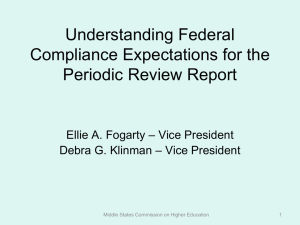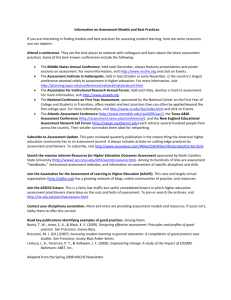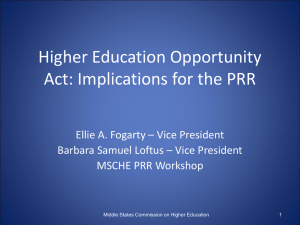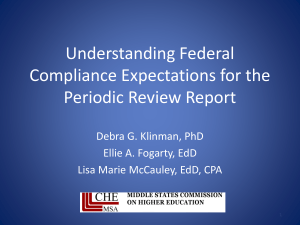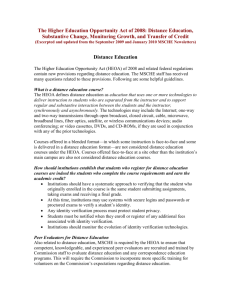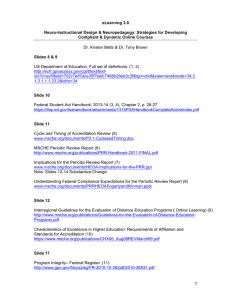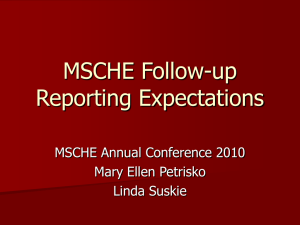Expectation and Accountability in Regional Accreditation
advertisement
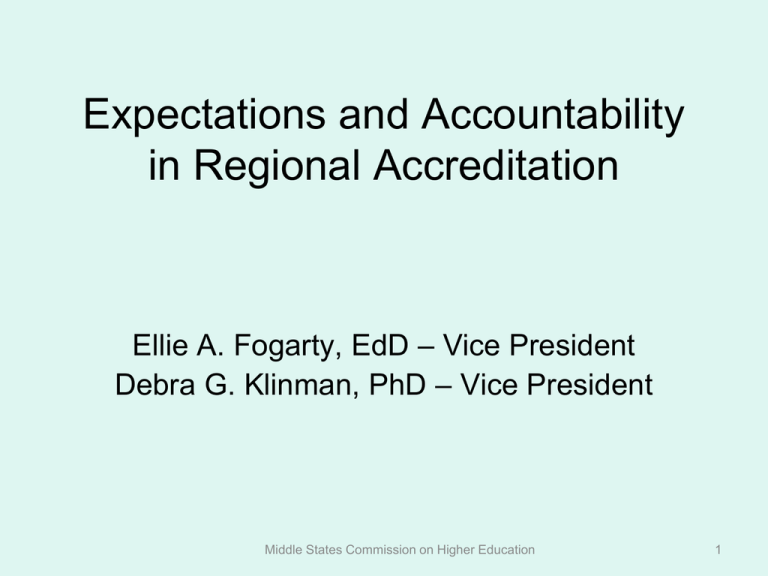
Expectations and Accountability in Regional Accreditation Ellie A. Fogarty, EdD – Vice President Debra G. Klinman, PhD – Vice President Middle States Commission on Higher Education 1 Overview • Expectations – National – Middle States • Accountability – Higher Education Opportunity Act of 2008 – Certification Statement • Resources for Additional Information Middle States Commission on Higher Education 2 National Context • Accreditation developed and evolved to promote mission-centered, continuous quality improvement through peer evaluation. • HEA 1965 (with subsequent re-authorizations, including 2008) named accreditors as gatekeepers for institutional access to federal funding. Various regulations have ensued. • Today, while accreditors continue to focus on quality improvement, USDE sees the primary purpose of accreditation as safeguarding federal funds. National Context • Increasing attention paid to higher education and accreditation • Concerns about rising costs and spending for Federal student aid • Mistrust about the peer review process • Occasional calls for “one-size-fits-all” metrics that do not respect unique missions Middle States Commission on Higher Education 4 What does the Commission expect of Teams & Chairs? • • • • Respect for the Mission of the host institution Collegiality and Integrity Expertise and Preparation Team reports based firmly on Middle States Standards • Evidence-based decisions • Professional judgment Middle States Commission on Higher Education 5 What can you expect from the Commission? • Team reports are read carefully and help MSCHE at the next levels of review – Committee on Evaluation Reports – Commission Meetings • Committee and Commission members work to ensure consistent application of Standards across institutions • MSCHE informs institution of final Commission action on reaccreditation Middle States Commission on Higher Education 6 Accountability • MSCHE values peer review that focuses on continuous improvement – Recognizes the importance to member institutions of Title IV funds and federal grants – Recognizes the need to assure the US Department of Education that member institutions are in compliance • MSCHE process for certification and verification of HEOA 2008 compliance Middle States Commission on Higher Education 7 Certification Statement • Signed by CEO and Board Chair • Attached to the executive summary of the Self-Study Report • Affirms compliance with – MSCHE Requirements of Affiliation – Accreditation-relevant federal requirements Middle States Commission on Higher Education 8 Middle States Commission on Higher Education 9 Distance Education • Distance Education – Instruction delivered via technology – Regular student/faculty interaction • Correspondence Education – Instructional materials delivered, mail or email – Student initiated interaction as needed Middle States Commission on Higher Education 10 Student Identity Verification • HEOA 2008: Institutions must document how student identity is verified – Secure username and password – Proctored exams – New technologies – Protection of student privacy – Notification of student fees at registration • Peer reviewers evaluate compliance Middle States Commission on Higher Education 11 Transfer of Credit • Generally addressed under Standards 8 and 11 • HEOA 2008: Institutions must publicly document – Criteria for Transfer Decisions – List of Articulation Agreements • Peer reviewers evaluate compliance Middle States Commission on Higher Education 12 Credit Hours • Unit of measurement of academic work • Federal definition consistent with Carnegie Unit • HEOA 2008: Institutions must document that any “reasonable equivalencies” can be verified through student learning outcomes • Peer reviewers evaluate compliance Middle States Commission on Higher Education 13 Credit Hours • Policies and procedures for awarding credit hours • Consistent application of these policies and procedures • Does the institution's assignment of credit hours conform to commonly accepted practice in higher education? Middle States Commission on Higher Education 14 Title IV Cohort Default Rate • Percentage of students in a given fiscal year who cannot repay federal loans • Each year, US Department of Education calculates and publishes the average rate • Institutions must document where they stand in relation to averages • Typically the responsibility of the financial aid office or CFO • Peer reviewers evaluate compliance Middle States Commission on Higher Education 15 Additional Resources US Dept. of Education http://www2.ed.gov/about/offices/list/ope/policy.html http://www2.ed.gov/policy/highered/leg/hea08/index.html http://ifap.ed.gov/dpcletters/attachments/GEN1106.pdf Official Cohort Default Rates for Schools http://www2.ed.gov/offices/OSFAP/defaultmanagement/cdr.html Middle States Commission on Higher Education http://www.msche.org/ Middle States Commission on Higher Education 16 Questions? Middle States Commission on Higher Education 17
